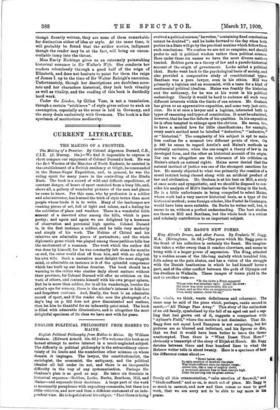CURRENT LITERATURE.
THE MAKING OF A FRONTIER.
The Making of a Frontier. By Colonel Algernon Durand, C.B., C.I.E. (.J. Murray. 16s.)—We find it impossible to express in short compass our enjoyment of Colonel Durand s book. He was the first Warden of the Marches of North Kashmir, he assisted in the establishment of a British residency at Gilgit, he commanded in the Hunza-Nagar Expedition, and, in general, he was the ruling spirit for many years in the controlling of the Hindu Kush. The book is a record of wild and difficult expeditions, of constant danger, of hours of sport snatched from a busy life, and, above all, a gallery of wonderful pictures of the men and places he came to know. For this man, who by profession is a soldier and administrator, has learned the trick of style better than most people whose trade it is to write. Many of the landscapes are cunning pieces of art, full of light and colour, and a feeling for the subtleties of place and weather. There is a wonderful little account of a deserted altar among the hills, which is pure poetry; and again and again we are delighted by a keenness of observation and perennial high spirits. Colonel Durand is, in the first instan.ce, a soldier, and he tells very modestly and simply of his work. The Mehtar of Chitral and his relatives are admirable pieces of portraiture ; and the whole diplomatic game which was played among those pathless hills has the excitement of a romance. The work which the author did was done by himself, for he was constantly left alone for months on end, the outer world shut off from him, and with no ally but his own wits. Such a narrative must delight the most sluggish mind, so admirable an instance is it of the splendid competence which has built up our Indian frontier. The book should be a warning to the critics who chatter daily about matters without their province, for Colonel Durand will offer no criticism on the work of others, and contents himself with his own proper sphere. But he is more than soldier, for in all his wanderings, besides the artist's eye for scenery, there is the scholar's interest in folk-lore and forgotten customs. And, finally, the book is an admirable record of sport, and if the reader who sees the photograph of a day's bag on p. 222 does not grow discontented and restless, then let him be thankful for an indecently quiet mind. The book is filled with admirable illustrations, and is altogether the most delightful specimen of its class we have met with for years.
































 Previous page
Previous page